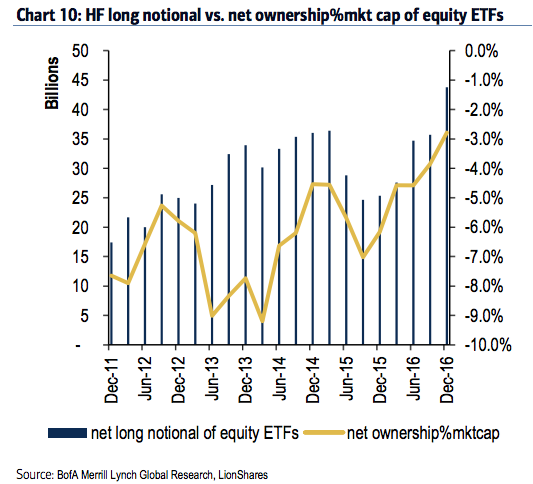Regular readers know I have very serious reservations about the rampant proliferation of ETFs.
In some instances (HY products) I can put my finger on exactly why (no liquidity for the underlying assets, a quarter of the float being used by institutions for daily liquidity needs, etc.), and in some instances (equity ETFs) I can’t quite get there.
But what I do know is that if you step back from the unit creation/destruction process (which generally seems to be functioning well) and just abstract yourself a bit, this just seems like a bad idea.
After all, ETFs are kind of, sort of derivatives. Now there’s a vociferous debate about that and I’m really – really – inclined to say it’s just semantics. Because at the end of the day, you’re buying something that represents something else even if it is, in a way, also a manifestation of that thing it represents.
Now we’ve got a situation where everyone is turning increasingly to passive, low-cost vehicles and indeed, hedge funds are throwing in the proverbial towel when it comes to beating benchmarks, going the least short equity ETFs on record in Q4:

(BofAML)
As I noted on Tuesday night, this ETF-dominated market environment was stress tested on the morning of August 24, 2015 and it failed miserably.
So at the end of the day, I’m not an ETF sponsor nor am I an AP, but I can’t help but wonder if this isn’t going to end up breaking down one day and the following excerpts from a new Deutsche Bank report (that most certainly wasn’t written in any kind of negative context) don’t to much to allay those fears…
Via Deutsche Bank
Institutional ETF assets grew by $213bn and reached $1.44 trillion in 2016 As of the end of 2016, almost 3,500 institutional investors held more than $1.44 trillion in ETF assets accounting for about 59% of all ETF assets. Investment Adviser remained as the dominant group with $813bn representing 33% of all ETF assets. Meanwhile, Private Bank/Wealth Management followed in a strong second place with $372bn in ETF assets or 15% of total assets.
Hedge funds recorded the strongest relative YoY growth in ETF assets Hedge funds saw an increase of 77% in ETF assets to $43.8bn, an increase from 1.2% to 1.8% in ETF ownership, and an increase of 17% in the number of funds using ETFs. Overall, they continued to prefer a reduced sample of ultra liquid ETFs. And had a very sizeable allocation to US Financials at the end of the year.

As per historical growth trends, ETF assets held by institutions and the number of products used by them have both grown more than 7 and 8 times in the last 10 years, respectively. Similarly, the number of different institutional investors using ETFs has almost double during the same period.












Leave A Comment